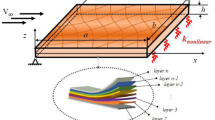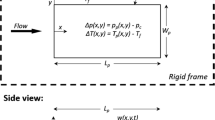Abstract
The skin panel structures of vehicles in supersonic flights are subjected to combined thermal, acoustic, and aerodynamic loads. These combined loads may cause a nonlinear dynamic response of the high-speed flight vehicle’s panel structures. Among these nonlinear dynamic responses, the snapthrough and limit cycle oscillation response seriously affect the fatigue failure of the panel structures. This work investigates the nonlinear dynamic responses using the numerical method, when combined supersonic aerodynamic, thermal, and random acoustic loads are applied to the panel structures simultaneously. To consider the thin and thick composite panels, the first-order shear deformation plate theory (FSDT) and the von Karman nonlinear displacement–strain relationship are applied. The aerodynamic load in the supersonic flow is modeled using the first-order piston theory. The thermal load distribution is assumed constant in the thickness direction of the composite panel. The random acoustic load is represented as stationary white-Gaussian random pressure with zero mean and uniform magnitude over the panels. The nonlinear equations of motion of the composite panel under combined loads are derived using the principle of virtual work and the finite element method. The static displacement, which is the solution of the nonlinear static equation, is calculated using the Newton–Raphson method, and the nonlinear dynamic equation is solved using the Newmark-β time integration method. Using these numerical methods, the nonlinear dynamic analyses are conducted under various loading conditions such as thermal–random acoustic loads, thermal–supersonic aerodynamic loads, and supersonic aerodynamic–thermal–random acoustic loads. Numerical results show the nonlinear dynamic response of the composite thin and thick panels such as snapthrough and limit cycle oscillation responses. Particularly, the snapthrough response is caused when the random acoustic load is applied appropriately to the thermally buckled composite plate when the aerodynamic load is not applied or applied with the relatively small magnitude of the dynamic pressure.



















Similar content being viewed by others
Abbreviations
- ε, κ, γ :
-
In-plane strain, bending strain, and shear strain vector, respectively
- A, As, B, D :
-
In-plane, transverse shear, in-plane bending, and bending stiffness matrices, respectively
- Ad and Ai :
-
Aerodynamic damping and aerodynamic influence matrices, respectively
- a and b :
-
Panel lengths in x and y directions (m), respectively
- FΔT and Facoustic :
-
Thermal load vector and random acoustic load vector, respectively
- h :
-
Thickness of panel (m)
- I0, I1, I2 :
-
Mass moments of inertia (kg m2)
- \( {\hat{\text{K}}} \) :
-
Tangential stiffness matrix
- KNT1 and KNT2 :
-
First- and second-order nonlinear transient stiffness matrices, respectively
- K ST :
-
Static-transient nonlinear stiffness matrix
- M :
-
Mach number
- \( \bar{\varvec{N}} \) and \( \bar{\varvec{M}} \) :
-
Resultant vectors of in-plane force and moment, respectively
- P eff :
-
Effective force vector
- P 0 :
-
Reference pressure (Pa)
- \( \overline{\varvec{Q}} \) :
-
Transformed reduced stiffness matrix
- Q :
-
Transverse shear force vector
- S0 and Sp :
-
Spectrum density and cross-spectral density function, respectively
- SPL:
-
Sound pressure level (dB)
- ΔTcr :
-
Critical temperature change (°C)
- u and v :
-
In-plane displacement vectors in x and y directions, respectively
- V a :
-
Air flow speed (m/s)
- w :
-
Transverse displacement vector in z direction
- \( {\bar{\mathbf{\alpha }}} \) :
-
Transformed thermal expansion coefficient vector (°/C)
- α1 and α2 :
-
Coefficients of thermal expansion in fiber direction and normal direction of fiber (°/C), respectively
- θx and θy :
-
Rotation vectors in the xz and yz planes, respectively
- ρ and ρa :
-
Material density (kg/m3) and air density (kg/m3), respectively
References
Oden JT, Thornton EA (1988) Analysis of flow-, thermal-and structural-interaction of hypersonic structures subjected to severe aerodynamic heating. Air Force Office of Scientific Research, TR-88-12
Duan B (2001) Suppression of composite panel vibration under combined aerodynamic and acoustic excitations at elevated temperatures using shape memory alloy. Ph.D Dissertation, Old Dominion University
Dowell EH (1966) Nonlinear oscillations of a fluttering plate. AIAA J 4(7):1267–1275
Dhainaut JM, Guo X, Mei C, Spottswood SM, Wolfe HF (2003) Nonlinear random response of panels in an elevated thermal-acoustic environment. J Aircr 40(4):683–691
Ibrahim HH, Tawfik M, Negm HM (2008) Thermoacoustic random response of shape memory alloy hybrid composite plates. J Aircr 45(3):962–970
Ibrahim HH, Yoo HH, Tawfik M, Lee KS (2010) Thermo-acoustic random response of temperature-dependent functionally graded material panels. Comput Mech 46(3):377–386
Kim YN, Park JS, Jeon MH, Go ES, Kim IG (2018) Nonlinear random response analyses of panels considering transverse shear deformations under combined thermal and acoustic loads. Shock Vib 2018:9751038
Lu Y (2008) Random vibration analysis of higher-order nonlinear beams and composite plates with applications of ARMA models. Ph. D Dissertation, Virginia Polytechnic Institute and State University
Lee SL, Kim JH (2010) Thermal post-buckling and the stability boundaries of structurally damped functionally graded panels in supersonic airflows. Compos Struct 92(2):422–429
Marzocca P, Fazelzadeh SA, Hosseini M (2011) A review of nonlinear aero-thermo-elasticity of functionally graded panels. J Thermal Stress 34(5–6):536–568
Navazi HM, Haddadpour H (2011) Nonlinear aero-thermoelastic analysis of homogeneous and functionally graded plates in supersonic airflow using coupled models. Compos Struct 93(10):2554–2565
Shiau LC, Kuo SY, Liu YP (2012) Aerothermoelastic analysis of composite laminated plates. Compos Struct 94(6):1982–1990
Pacheco DRQ, Marques FD, Natarajan S, Ferreira AJM (2017) Nonlinear finite element post-flutter analysis of multibay composite panels in supersonic regime. Compos Struct 180:883–891
Pacheco DRQ, Ferreira AJ, Marques FD (2018) On the effects of structural coupling on the supersonic flutter and limit cycle oscillations of transversely reinforced panels. J Fluids Struct 79:158–170
Zhao H, Cao D (2015) Supersonic flutter of laminated composite panel in coupled multi-fields. Aerosp Sci Technol 47:75–85
Irvine T (2013) Effective modal mass and modal participation factors. http://www.vibrationdata.com/tutorials2/ModalMass.pdf. Accessed 12 June 2019
Case JJ (2017) Numerical analysis of the vibration and acoustic characteristics of large power transformers. Master Dissertation, Queensland University of Technology
Hardin JC (1986) Introduction to time series analysis. NASA-RP-1145
Ashley H (1956) Piston theory-a new aerodynamic tool for the aeroelastician. J Aeronaut Sci 23(12):1109–1118
Dowell EH (1970) Panel flutter-A review of the aeroelastic stability of plates and shells. AIAA J 8(3):385–399
Pidaparti RMV and Yang HTY (1993) Supersonic flutter analysis of composite plates and shells. AIAA J 31(6):1109–1117
Reddy JN (2006) An introduction to the finite element method, 3rd edn. McGraw-Hill, New York, pp 324–326
Averill R and Reddy JN (1993) Thermomechanical postbuckling analysis of laminated composite shells. In: AIAA 34th structures, structural dynamics and materials conference. pp 1337
Dowell EH (1996) Nonlinear oscillations of a fluttering plate. AIAA J 4(7):1267–1275
Xue DY, Mei C (1993) Finite element nonlinear panel flutter with arbitrary temperatures in supersonic flow. AIAA J 31(1):154–162
Acknowledgements
This study was supported by the Agency for Defense Development. (Assignment number: ADD-06-201-801-014) and this work was supported by research fund of Chungnam National University.
Author information
Authors and Affiliations
Corresponding author
Additional information
Publisher's Note
Springer Nature remains neutral with regard to jurisdictional claims in published maps and institutional affiliations.
Appendix A
Appendix A
The coefficients, matrices, and vectors for the Newmark-β time integration are defined as follows:
Rights and permissions
About this article
Cite this article
Lee, HB., Kim, YN., Choi, IJ. et al. Nonlinear Dynamic Responses of Shear-Deformable Composite Panels under Combined Supersonic Aerodynamic, Thermal, and Random Acoustic Loads. Int. J. Aeronaut. Space Sci. 21, 707–722 (2020). https://doi.org/10.1007/s42405-019-00242-w
Received:
Revised:
Accepted:
Published:
Issue Date:
DOI: https://doi.org/10.1007/s42405-019-00242-w




